“Woman with a Parasol” by Claude Monet – An In-Depth Analysis
Woman with a Parasol by Claude Monet is widely considered one of the most iconic examples of an Impressionist painting. In this article, we will look at this oil painting in the context of Claude Monet’s life and career. We will also do a Woman with a Parasol analysis by looking at the technical elements of the Woman with a Parasol painting, such as composition, color and light use, subject matter, and brushwork.
Artist Abstract: Who Was Claude Monet?
Claude Monet was a French painter who was a leading figure in the Impressionist movement. He was born in 1840 on November 14, in Paris. He grew up in Le Havre, a coastal city in Normandy, where he developed a passion for drawing and painting at a young age.
In 1859, Monet began studying art at the École des Beaux-Arts in Paris, where he was trained in the traditional techniques of drawing and painting.
After completing his studies, Monet returned to Le Havre and began painting landscapes and seascapes. He was particularly interested in representing the impacts of light and color on the natural world. In 1865, Monet met fellow artist Pierre-Auguste Renoir, and the two began working together. They were joined by other artists, including Alfred Sisley and Frédéric Bazille, and together they formed the core of the Impressionist movement.
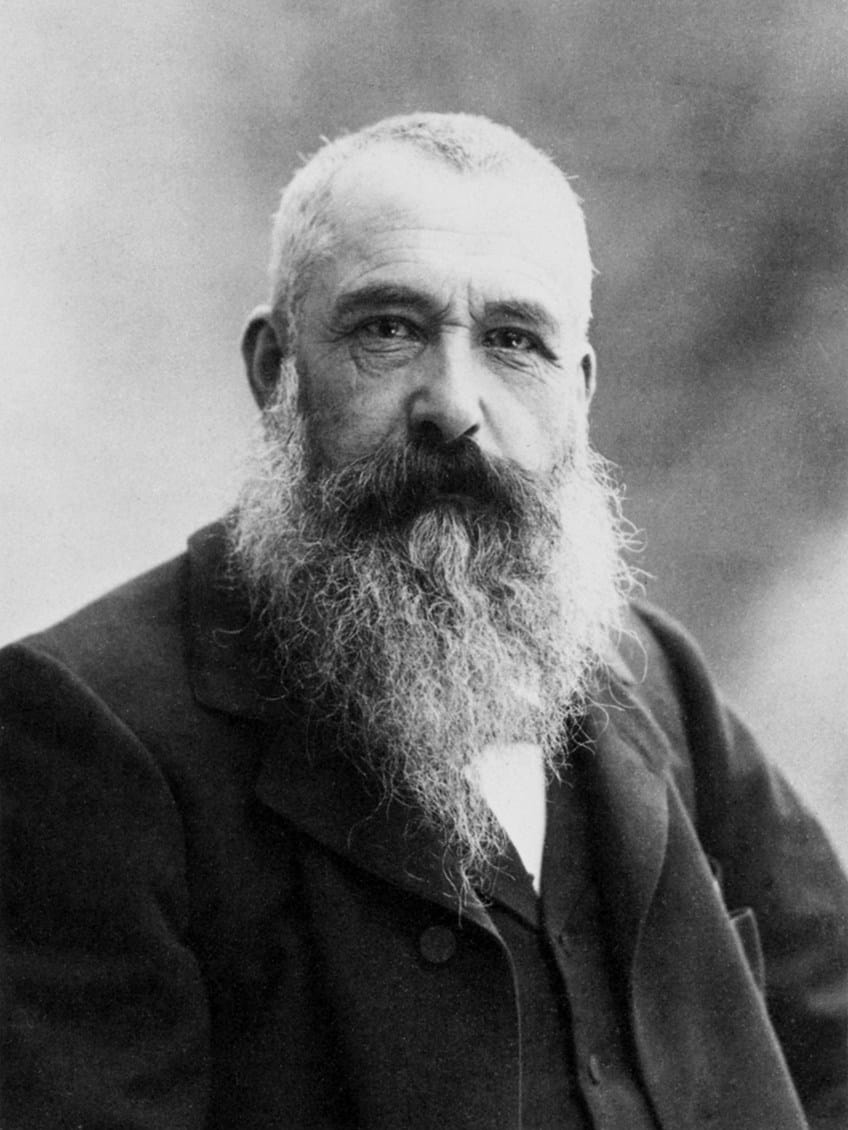
The Impressionists were a bunch of artists who sought to free themselves from the constraints of traditional painting approaches and subject matter. They were interested in capturing the fleeting results of light and color affected by the sun and seasons. They sought to paint the world as they saw it, rather than adhering to traditional conventions.
Monet was at the forefront of this movement, and his early works, such as Impression, Sunrise (1872), and Woman with a Parasol – Madame Monet and Her Son (1875), were among the first paintings to be labeled as Impressionist.
Monet’s work was initially met with skepticism and criticism from the art world. Many critics were puzzled by his unconventional compositions and use of light and color, and the first Impressionist exhibition was met with mixed reviews. However, over time, Monet’s work gained recognition and he became one of the most renowned artists of his time. He continued to paint throughout his life, and his later works, such as The Water Lilies (1919) and The Japanese Footbridge (1899), are considered to be among his finest.
Woman with a Parasol (1875) by Claude Monet in Context
| Artist | Claude Monet (1840 – 1926) |
| Date Painted | 1875 |
| Medium | Oil on canvas |
| Type of Painting | Landscape; figure |
| Dimensions (cm) | 100 x 82 |
| Art Movement | Impressionism |
| Series | Woman with a Parasol (of three paintings) |
| Location | National Gallery of Art, Washington, D.C., United States |
Woman with a Parasol – Madame Monet and Her Son (shortened to Woman with a Parasol) was painted by Claude Monet in the early stage of Monet’s Impressionist explorations. It is also similar in mood and theme to the Haystack series the painter started creating in 1891.
These two series of paintings were a departure from Monet’s earlier works, which were mostly landscapes and seascapes.
Instead, the Haystacks and Woman with a Parasol paintings focused on more domestic subjects, such as gardens, ponds, and people. In this section of the article, we will contextualize Woman with a Parasol by Claude Monet within the socio-political climate in France, as well as within the artist’s career.
Woman with a Parasol in the Context of Monet’s Career
At the time of painting Woman with a Parasol – Madame Monet and Her Son, Claude Monet was living and working in Argenteuil, a small town on the outskirts of Paris. He had been living there for a couple of years and was traveling to Paris often to meet other creatives.
At this time, Monet was deeply immersed in the Impressionist movement, which he had helped to establish.
In the years leading up to Woman with a Parasol – Madame Monet and Her Son, Monet created many notable paintings that showcased his Impressionist style. Some of these include Impression, Sunrise (1872), which is often considered the first Impressionist painting, and The Red Balloon (1873), which depicts a young boy holding a red balloon against a vibrant blue sky. These paintings, along with many others, cemented Monet’s reputation as a leading figure in the Impressionist movement.
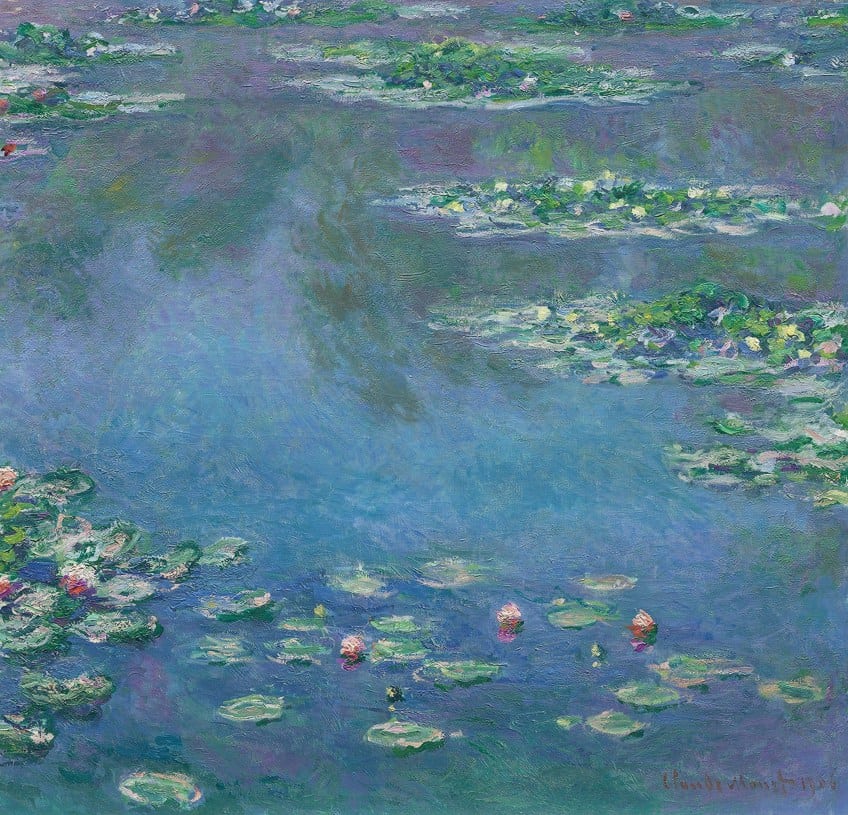
In 1874, Monet and several other artists, including Renoir and Sisley, held an exhibition in Paris that was met with great success. This exhibition, which was organized by the artist Paul Durand-Ruel, helped to solidify the Impressionist movement and brought Monet and his contemporaries widespread recognition.
The following year, in 1875, Monet completed Woman with a Parasol – Madame Monet and Her Son.
In the broader context of Monet’s career, the Woman with a Parasol series was an important step in the development of his artistic style. The paintings allowed Monet to experiment with different techniques and subjects. This exploration led to him becoming one of the most famous and esteemed artists of his time.
A Socio-Political Overview of the Woman with a Parasol Painting
The Woman with a Parasol painting was painted at a time of great political and social upheaval in France. The country was undergoing rapid industrialization, which led to the growth of cities and the rise of a new urban working class. At the same time, the French government was struggling to maintain its power and prestige in the face of growing challenges from other European nations.
Despite political and social obstacles, the arts thrived in France during this period.
The Impressionist movement, of which Monet was a leading member, was gaining popularity and recognition. Monet’s paintings, including Woman with a Parasol, were at the forefront of this artistic movement and helped to define the aesthetic of the time.
Pertinent Themes: What Made Woman with a Parasol Relevant at That Time?
The themes in Woman with a Parasol were relevant to the socio-political context of France at the time it was painted for a couple of reasons. One is that the painting reflects the changes that were taking place in French society during this period. The Industrial Revolution brought about significant economic and social changes, and many people were moving from the countryside to the city.
The painting captures this shift, depicting a rural scene with modern elements, such as the parasol, which was a fashionable accessory at the time.

Another reason why the themes of the painting were important to the movement in was painted in France is that the painting also reflects the changing role of women in society. Camille, Monet’s wife, is depicted as a strong and independent woman, holding a parasol and walking confidently with their son. This portrayal of a woman outside of the traditional domestic sphere was groundbreaking at the time and reflects the growing movement for women’s rights in France.
Overall, Woman with a Parasol is a rich and complex work that reflects the changes and challenges of its time.
Woman with a Parasol Analysis: A Discussion of the Visual Techniques
It captures a moment of peacefulness and domesticity, depicting the joys of motherhood and family life. The use of color, light, form, and perspective all work together to create a sense of tranquility and beauty. In this section of the article, we will proceed to do a visual analysis of Woman with a Parasol by Claude Monet.
Subject Matter
The painting depicts a woman, who is believed to be Monet’s wife, Camille, holding a parasol and standing next to a young boy, who is believed to be their son Jean. The two figures are positioned on a grassy field with a small pond in the background.
The woman is dressed in a white dress and a hat, while the boy is wearing a sailor suit.
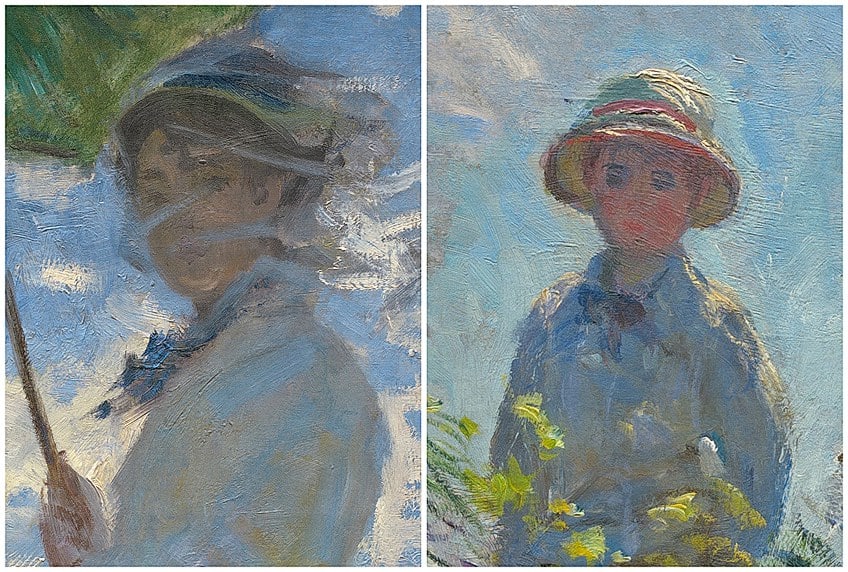
A characteristic of Impressionism is the focus on everyday, ordinary subjects. Monet’s painting depicts a simple family outing, with Camille and Jean strolling through a field of flowers. The figures are depicted in a casual, relaxed pose, adding to the sense of spontaneity and naturalness in the artwork. The inclusion of the parasol, held by Camille, adds a touch of elegance and femininity to the scene.
Color and Light
Monet was known for working quickly and outdoors, often painting in Plein air (in the open air). It is likely that Monet painted Woman with a Parasol outdoors, capturing the light and colors of the landscape as he saw them. Monet would have likely set up his easel and painted on the grassy field depicted in the painting, working quickly to capture the moment before the light changed. Monet has used a light and airy color palette, with pale blues, greens, and pinks predominating.
The light in the painting appears to be coming from the upper left-hand corner, casting soft shadows on the figures and the ground. The colors are blended together seamlessly, giving the painting a dreamlike quality.
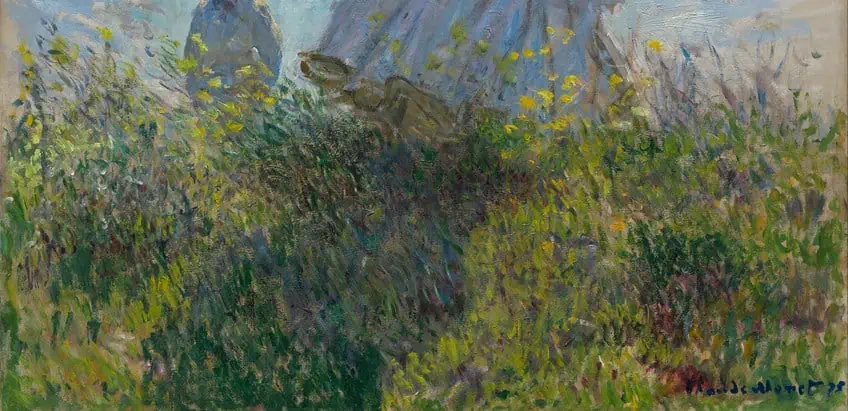
Movement and Texture
Monet’s paintings are known for their vibrancy and sense of movement, and Woman with a Parasol is no exception. In terms of form and texture, the painting is quite flat. The figures and the landscape are depicted in a simplified manner, with little use of texture or fine details.
This contributes to the overall ethereal quality of the painting. The figures are positioned slightly off-center, creating a sense of motion and energy.
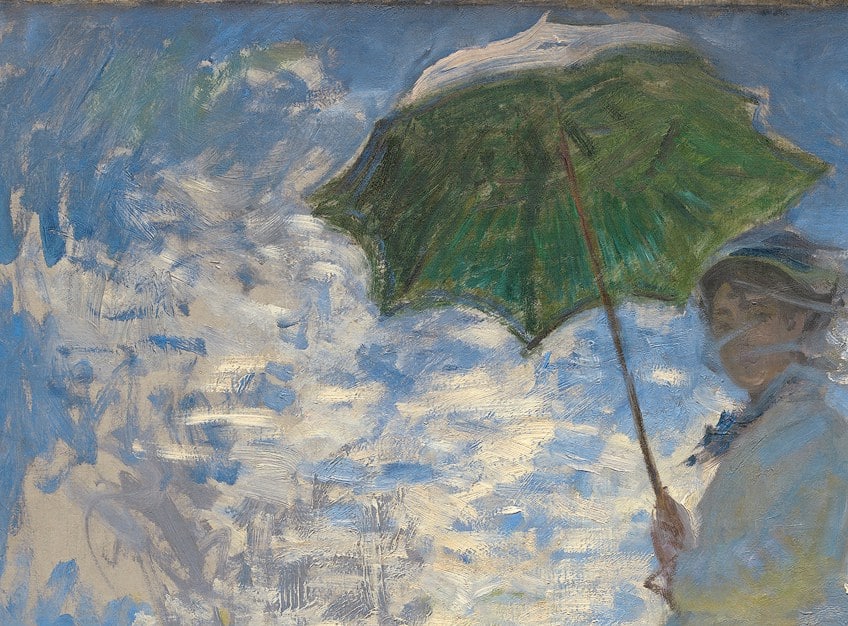
Monet uses vibrant, bold brushstrokes to depict the bright sunshine and colorful flowers that surround Camille and Jean. The light filters through the leaves of the trees, casting dappled shadows on the figures and the ground. This use of light and color further contributes to the sense of movement and energy, as if the viewer is glimpsing a momentary impression of the scene rather than a static, carefully planned composition.
Perspective
The perspective in the painting is also notable. The figures are depicted from a slightly elevated viewpoint, looking down on them. This perspective allows the viewer to see the entire landscape, including the pond in the background. It also creates a sense of intimacy and closeness between the viewer and the figures.

The Implications of Woman with a Parasol
In the last section of this article, we will look at how the public responded to Woman with a Parasol when it was first exhibited. We will also look at the rest of the series and how Woman with a Parasol – Madame Monet and Her Son compares to the other artworks in the series.
The First Exhibition and the Public’s Reaction to Woman with a Parasol
Woman with a Parasol was first exhibited in 1875 at the first Impressionist exhibition in Paris. The exhibition was organized by a group of artists who had come to be known as the Impressionists and featured several paintings by Monet and other leading members of the movement.
The exhibition was met with mixed reviews from the public and the art world.
Some critics were intrigued by the Impressionists’ use of light and color, while others were puzzled by their unconventional compositions and subject matter. Despite this initial skepticism, the exhibition helped to bring the Impressionist movement to the attention of the public and paved the way for future exhibitions and critical recognition.
Contextualizing the First Woman with a Parasol Within the Series
There are several key differences between Claude Monet’s painting Woman with a Parasol – Madame Monet and Her Son and his later paintings, Woman with a Parasol, facing left (1886) and Woman with a Parasol, facing right (1886), as well as John Singer Sargent’s painting Two Girls with Parasols at Fladbury (1889).
This painting was created around the time Monet was exploring the same theme.

Different Subject Matters
One of the most significant differences is the subject matter of the paintings. While Monet’s Woman with a Parasol – Madame Monet and Her Son depicts his wife Camille and their son Jean in a field of flowers, the later paintings in the series show Camille alone, holding a parasol and facing either left or right. On the other hand, Sargent’s painting features two young girls holding parasols and standing in a garden.
This difference in subject matter reflects the distinct focus and interests of the artists, as well as the changing styles and techniques within the broader context of impressionism.

Variations of Color and Light
Another key difference between the paintings is the use of light and color. Monet’s earlier painting, Woman with a Parasol – Madame Monet and Her Son features bold, vibrant brushstrokes and a bright, sunny color palette. The later paintings in the series, as well as Sargent’s painting, have a more muted, subdued color scheme, with softer, more delicate brushstrokes.
This change in the use of light and color reflects the evolution of Impressionist techniques and the artists’ individual styles.
Changes in Composition
Additionally, the compositions of the paintings differ. Monet’s earlier painting features a dynamic, off-center composition, with the figures positioned slightly to the left of the canvas and the plants and trees leading the viewer’s eye towards them.
The later paintings in the series have a more static, balanced composition, with Camille positioned centrally and facing either left or right.
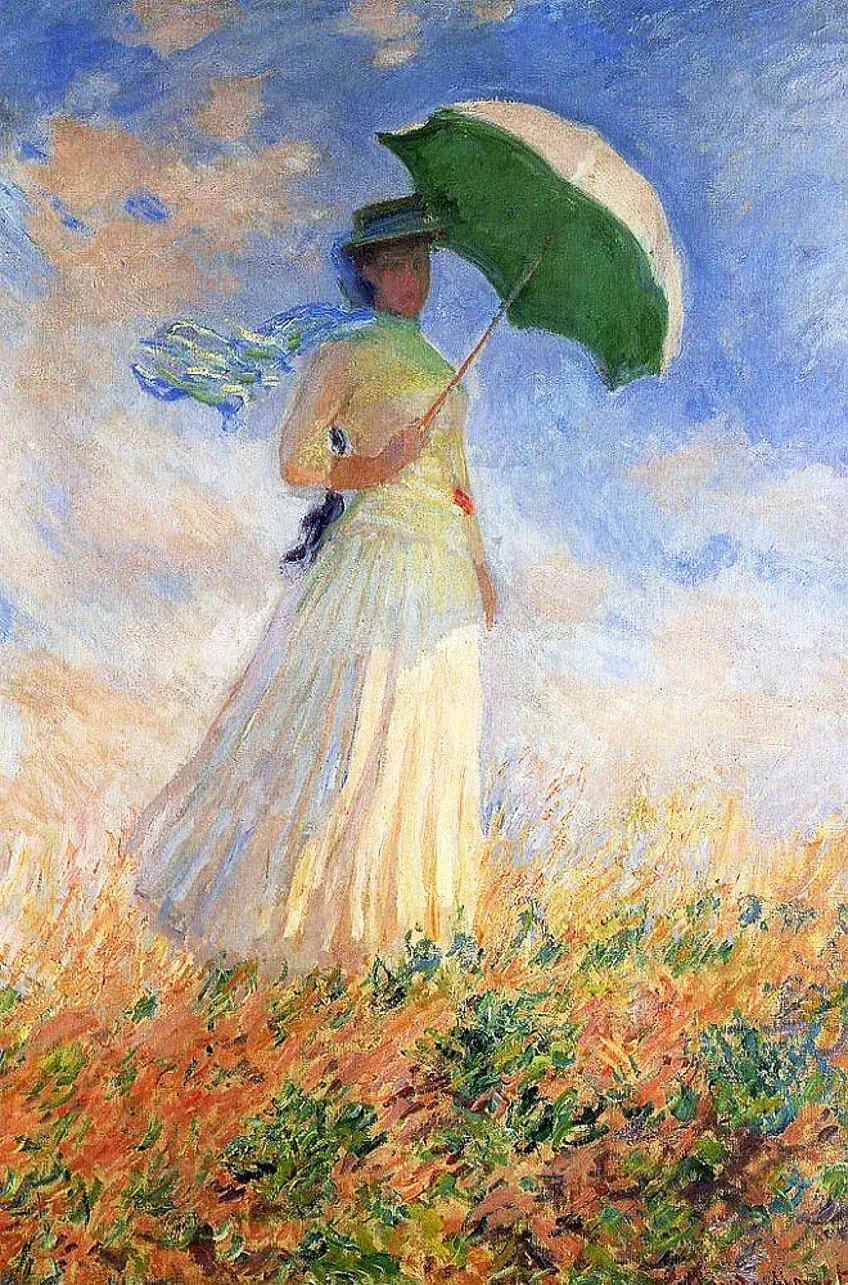
Sargent’s painting also has a balanced composition, with the two girls standing side by side in the center of the canvas. This difference in composition reflects the artists’ individual approaches to composition and the ways in which they sought to create a sense of movement and energy in their paintings.
Monet’s work had a profound influence on the Impressionist movement and on art in general. The technical choices he made in Woman with a Parasol – Madame Monet and Her Son are essential to the artwork’s Impressionist style. The use of light and color, focus on everyday subjects, and dynamic composition all contribute to the painting’s ability to capture the fleeting, ephemeral nature of the natural world. These elements make Woman with a Parasol a quintessential example of impressionism in art.
Frequently Asked Questions
What Is Woman with a Parasol – Madame Monet and Her Son About?
Woman with a Parasol – Madame Monet and Her Son (1875) depicts Camille and Jean in a field of flowers, with the bright sunshine and colorful plants providing a contrast to the figures’ elegant clothing and the graceful curve of the parasol. The painting’s dynamic composition and use of light and color create a sense of movement and energy, capturing the fleeting moment of the family’s outdoor outing.
Did Monet Create Multiple Woman with a Parasol Paintings?
Monet created a total of three paintings within the Woman with a Parasol series. Woman with a Parasol – Madame Monet and Her Son (1875) is the first painting iteration of a similar composition. The series also include Woman with a Parasol, facing left (1886) and Woman with a Parasol, facing right (1886).
Why Was Woman with a Parasol Series So Important in Monet’s Oeuvre?
The paintings in the Woman with a Parasol series are considered to be some of Monet’s most successful and well-known works. They showcase his mastery of Impressionist techniques, including the use of bold brushstrokes, vibrant colors, and a focus on capturing the fleeting qualities of the natural world.
Nicolene Burger, a South African multimedia artist and creative consultant, specializes in oil painting and performance art. She earned her BA in Visual Arts from Stellenbosch University in 2017. Nicolene’s artistic journey includes exhibitions in South Korea, participation in the 2019 ICA Live Art Workshop, and solo exhibitions. She is currently pursuing a practice-based master’s degree in theater and performance. Nicolene focuses on fostering sustainable creative practices and offers coaching sessions for fellow artists, emphasizing the profound communicative power of art for healing and connection. Nicolene writes blog posts on art history for artfilemagazine with a focus on famous artists and contemporary art.
Learn more about Nicolene Burger and about us.
Cite this Article
Nicolene, Burger, ““Woman with a Parasol” by Claude Monet – An In-Depth Analysis.” artfilemagazine – Your Online Art Source. January 20, 2023. URL: https://artfilemagazine.com/woman-with-a-parasol-by-claude-monet/
Burger, N. (2023, 20 January). “Woman with a Parasol” by Claude Monet – An In-Depth Analysis. artfilemagazine – Your Online Art Source. https://artfilemagazine.com/woman-with-a-parasol-by-claude-monet/
Burger, Nicolene. ““Woman with a Parasol” by Claude Monet – An In-Depth Analysis.” artfilemagazine – Your Online Art Source, January 20, 2023. https://artfilemagazine.com/woman-with-a-parasol-by-claude-monet/.



